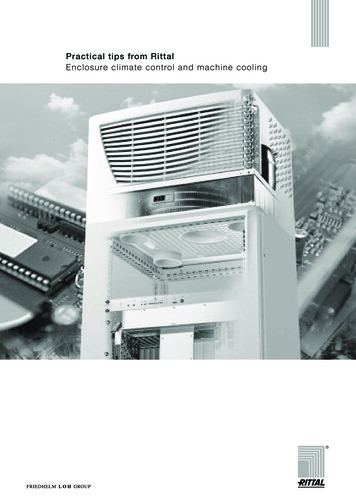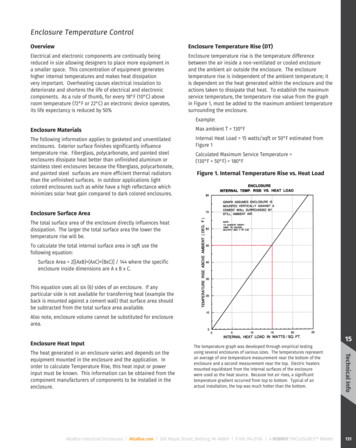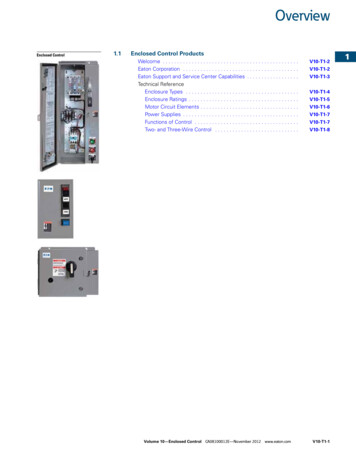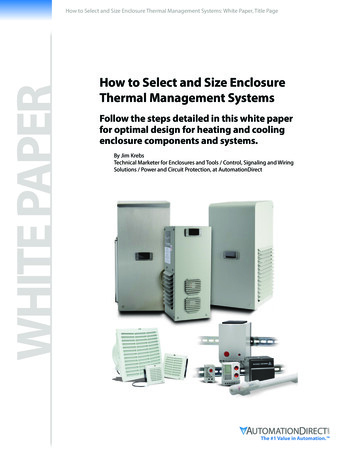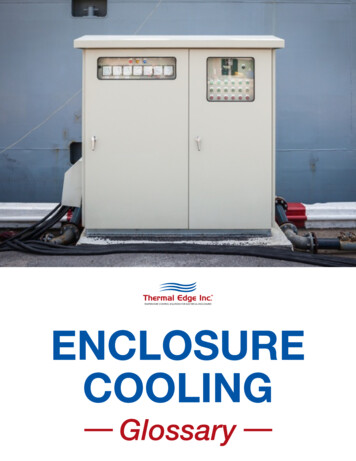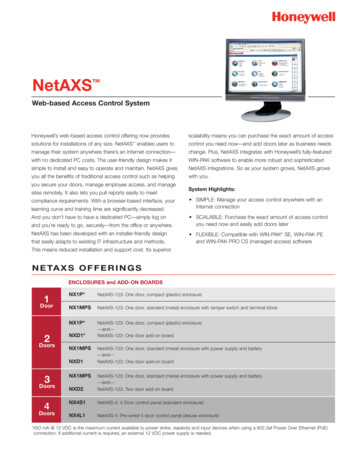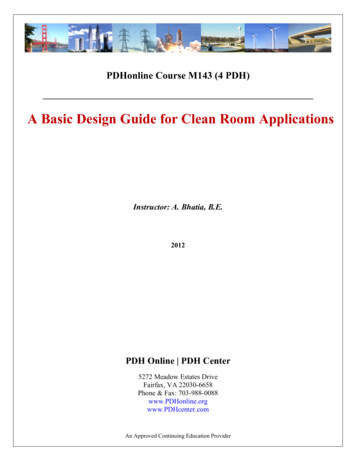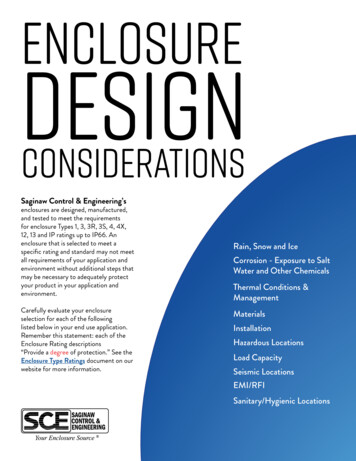
Transcription
EnclosureDesignConsiderationsSaginaw Control & Engineering’senclosures are designed, manufactured,and tested to meet the requirementsfor enclosure Types 1, 3, 3R, 3S, 4, 4X,12, 13 and IP ratings up to IP66. Anenclosure that is selected to meet aspecific rating and standard may not meetall requirements of your application andenvironment without additional steps thatmay be necessary to adequately protectyour product in your application andenvironment.Carefully evaluate your enclosureselection for each of the followinglisted below in your end use application.Remember this statement: each of theEnclosure Rating descriptions“Provide a degree of protection.” See theEnclosure Type Ratings document on ourwebsite for more information.Rain, Snow and IceCorrosion - Exposure to SaltWater and Other ChemicalsThermal Conditions &ManagementMaterialsInstallationHazardous LocationsLoad CapacitySeismic LocationsEMI/RFISanitary/Hygienic Locations
1Rain, Snow and IceA common misconception is that a Type 4, 4X and IPX5, IPX6 enclosure can be used in any indoor or outdoorapplication, regardless of its environment, exposure, or installation, and will remain “water tight.” This is not true.Additional steps may be necessary to properly protect your product in its environment. (Water Tight Not WaterProof.)What does the Type 4 & 4X test involve?Protection against the ingress of water - hose down test. The enclosure and its external mechanisms are subjectedto a stream of water from a hose that has a 25 mm (1 in) inside diameter nozzle that delivers at least 240 L (65 gal)per minute. The nozzle is held 3.0 to 3.5 m (10 to 12 ft) from the enclosure, and the spray of water is directed atall points of potential water entry, such as seams, joints, external operating mechanisms, and the like. The nozzle ismoved along each test point one at a time in a uniform nominal rate of 6 mm/sec (¼ in/sec). A conduit is installed toequalize internal and external pressures. At the end of the test no water has entered the enclosure. See UL 50E andCSA 22.2 for complete requirements.IEC IP Code second character in IPX5 & IPX6 test?Protection against the ingress of water – IPX5 & IPX6 hose down test. The enclosure and its external mechanismsare subjected to a stream of water from a hose that has a 6.3 mm (0.25 in) for IPX5 and 12.5 mm (0.5 in) for IPX6inside diameter nozzle that delivers at least 12.5 L (3.5 gal ) per min. on IPX5 or at least 100 L (26.5 gal ) per min.on IPX6.The nozzle is held 2.5 m to 3 m (8.2 to 9.8 ft) for IPX5 and IPX6 from the enclosure, and the spray of water isdirected at all surface areas likely to be sprayed. Test duration is 1 minute per square Meter per surface with aminimum of 3 minutes total test duration for IPX5 and IPX6. The nozzle is moved along the entire test surface.A conduit or vent is installed to equalize internal and external pressures.See IEC 60529 for complete requirements.Outdoor ApplicationsFor all enclosures in outdoor applications with direct exposure to rain, snow, and ice, a drip shield is alwaysrecommended, and in most applications, it is required. Drip shields minimize risk related to long term exposure torain and damaging effects of snow and ice being trapped in the external cavity of the door and enclosure body andprolonged exposure to water that may lead to water being absorbed into the gaskets.Proper VentilationAn enclosure that is not adequately vented and in an outdoor or wash down environment may lead to leakage due todrastic temperature changes caused by rainfall or hose down with cold or hot water. An enclosure that is subjectedto a temperature differential of just 20 to 30 degrees, for instance one with an internal temperature of about 85 Fwhich has hose directed water applied with city water (average temperature of 55 F), can result in damage to theseal. When the water is applied, the temperature inside the enclosure rapidly drops, the air contracts and creates avacuum inside the enclosure that starts to draw water through at the weakest link, or even pull water through thegasket, almost immediately and until the pressure is equalized. The smaller the enclosure or part the quicker thisreaction occurs. An enclosure in an outdoor application will be exposed to conditions that are far more severe takingin to consideration the solar gain and the internal temperature rise of the enclosure and rain temperatures that canbe as low as 32 F. In some installations of enclosures, a wire conduit may be found to be adequate to serve as its ventand equalize the pressure, but in most applications is not enough. In Type 4 and 4X Enclosures, no drain holes arerequired or provided, so it is increasingly important that sufficient ventilation exists or Type 4, 4X breathers or Type4, 4X drain/breathers are added to equalize pressure.Back to Top2
Enclosures require to be evaluated by the manufacture of the final assemblyEnclosure are tested Empty without equipment installed and require adequate drainage should any water enter, orif no drainage is provided shall be evaluated by the manufacture of the final assembly to the relevant standard andIP 60529 to the General - Acceptance conditions.Type 3R RainproofA true complete Type 3R Rainproof enclosure is provided with drip shield and drainage holes that also serve asventilation to equalize pressure as required. A multi-listed enclosure such as an enclosure listed as Type 3R, 4 & 12is provided with additional instructions for installation of a drip shield and drainage holes. What does the Type 3RRain test involve? Enclosures with a conduit connected shall be mounted as in actual service, the test apparatusconsists of at least three spray heads mounted in a water supply pipe rack. The enclosure is positioned in the focalarea of the spray heads so that the greatest quantity of water is likely to enter the enclosure. The water pressureis maintained at 34.5kPa (5 psi) at each spray head and a continuous water spray shall be applied for one hour.Type 3R enclosure is considered to have met the requirements if at the conclusion of the test a) There is noaccumulation of water within the enclosure; and b) No water has entered the enclosure at a level higher than thelowest live part.Attention!Saginaw Control & Engineering recommends when enclosures are installed in full outdoor exposure and extremeweather environments the use of drip shield, ventilation and drainage. Saginaw Control & Engineering does notrecommend the use of polycarbonate viewing windows for use as type 4, 4X, IP55, IP56, IP66 or any outdoorapplication when installed in full exposure and extreme weather environments. Carefully considered and evaluate yourend use environment for the all reasons described above.Back to Top3
2Corrosion - Exposure to Salt Water or Other ChemicalsEvaluate the environment of the end use location and the chemicals that the enclosure may be exposed to.Corrosion Protection RequirementsThe corrosion protection requirements for a Type 1, 12, 3R, 4 and 4X are very specifically targeted and an enclosuremay be manufactured out of a combination of materials that meet the corrosion requirements for the enclosure type,although may not be adequate for your application without making changes.What does the Type 4X Corrosion test involve?Indoor Type 1 & 12-24-hour salt spray. The test apparatus shall consist of a fog chamber, a salt-solution reservoir, asupply of compressed air, atomizing nozzles, support for the enclosure, provision for heating the chamber, and meansof control. Type 3R, 4 test - 1200-hour moist carbon dioxide-sulfur dioxide-air, 600-hour salt spray. (Two notscribed specimens and two specimens scribed with edges taped) Outdoor Type 3RX, 4X is the same Type 3R, 4 testwith an additional 200-hour salt spray or 800 hours. See UL 50E and CSA 22.2 for complete requirements.The primary targets of the corrosion test requirements are with respect to water, salt water, and basic air pollutants.Salt water should be considered when applications are near coastlines and roadways, effects of salt air can be a concernfrom 5 miles to 25 mile inland depending on the region. The effects of salt water can be extreme even with type 304stainless steel although the effects are more cosmetic than structural or functional. If cosmetics are critical, then type316 stainless steel may be a better choice, yet it is not impervious to rust and staining caused by airborne debris andchemicals that may end up on the material surface.Performance with respects to common outdoor exposure and water.Scale from 1-8 - 8 being the highest performing.1Steel with polyester Powder coat finish2Steel with Epoxy Zinc rich Powder base with polyester Powder coat finish.3Galvannealed Steel with polyester Powder coat finish4Aluminum with polyester Powder coat finish5Polycarbonate6Fiberglass7304 Stainless Steel8316 Stainless SteelOther chemicals, such as acids, solvents, fluoride, chloride, cleaning detergents and hundreds of other chemicals ina multitude of different concentrations, can severely effect even the most resilient materials, for instance type 316stainless steel, and are not considered part of their corrosion performance evaluation.Galvanic CompatibilityGalvanic corrosion (sometimes called dissimilar metal corrosion) is the process by which materials in contact with oneanother oxidize or corrode, accelerating the deterioration of one of the metals. In some instances, galvanic corrosioncan even be helpful in some applications. For example, if pieces of zinc or copper are attached to the bottom of a steelwater tank, the zinc or copper will become the anode, and it will corrode. The steel in the tank becomes the cathode,and it will not be affected by the corrosion. This technique is known as cathodic protection. The metal to be protectedis forced to become a cathode, and it will corrode at a much slower rate than the other metal, which is used as asacrificial anode.Attention! Saginaw Control & Engineering recommends the application and environment is carefully considered andevaluated for the reasons described above. There may be chemicals, acids, solvents, or gasses outside the scope of thecorrosion resistant requirements in your application or environment that will adversely affect the performance of theenclosure or materials used in its construction.Back to Top4
3Thermal Conditions & ManagementEvaluate environment of end use location and its exposure to ambient heat, internal heat, and solar gain.The temperature, both outside the enclosure and inside the enclosure, must be carefully considered for the application, regardlessof the enclosure type. Excessive heat or cold can seriously compromise both the performance and functionality of enclosure inits end environment as well as the equipment it houses.What temperatures can an enclosure sustain?Plastics, windows, gaskets, and coatings are tested for their performance – (Resistance Hot and Cold). Cooled to a temperatureof minus 30 C (minus 22 F) for a period of 24 hours and then subjected to an impact and crush resistant test. Heat - Max.temperature for outdoor application 60 C/140 F test in circulating air for 168 hours have a tensile strength of not less than 75percent and an elongation of not less than 60 percent of values determined for unaged samples. At the conclusion of the tests,there is no visible deterioration, deformation, melting, or cracking of the material. See UL 50E and CSA 22.2 for completerequirements.Internal Heat LoadInternal heat produced by the electronic components can considerably increase the internal temperature (Heat Rise). Just1 watt added to 1 cubic foot of space can increase the internal temperature by as much as 3 F. Different base materials havedifferent thermal conductivity (K Value), stainless, aluminum, fiberglass, and steel, as well as their finish, greatly influence internalheat dissipation and heat rise, so they must be considered when determining the proper thermal management options for theapplication. Choosing the incorrect thermal management option can compromise the performance, components, electronicsand environmental rating of your enclosure.Solar Gain, High Ambient ConditionsSolar Gain refers to the increase in temperature in a space that results from solar radiation. The amount of solar gain increaseswith the strength of the sun. Shading, reflection, and color can be used to minimize the effects and cooling requirements.An enclosure in a location with full exposure to the sun and 0 watts of internal heat load can reach temperatures that exceed160 F degrees and exceed the performance limitation of test requirements and performance limitation of some materials, suchas polycarbonate windows.As a result of the Internal heat load, higher temperatures, solar gain or the combination of some or all of these conditions, coolingsystems, such as Air Conditioners, Heat Exchangers or Chillers are often required in many applications whether the enclosure isindoors or outdoors, insulated or un-insulated.Low Ambient ConditionsHeat may be required to raise the temperature of the control panel, for freeze protection, reduce humidity, prevent damage tothe electronic components or improve efficiency of electronics. As the complexity of electronics increase it becomes even morecritical to safeguard the enclosures.Mounting heaters along with a thermostat near the bottom of the enclosure provides the best performance. Thermostats canbe incorporated as part of the heater or as a standalone item. The controller should be positioned in a neutral location that willprovide an average humidity or temperature reading. Placing the thermostat too close to the heater may provide a reading thatis influenced by the direct heat of the heater.SCE Thermal thermal-calculator/Attention! Saginaw Control & Engineering recommend the use of drip shield, ventilation and drainage when installed in fulloutdoor exposure and extreme weat
Protection against the ingress of water - hose down test. The enclosure and its external mechanisms are subjected to a stream of water from a hose that has a 25 mm (1 in) inside diameter nozzle that delivers at least 240 L (65 gal) per minute. The nozzle is held 3.0 to 3.5 m (10 to 12 ft) from the enclosure, and the spray of water is directed atFile Size: 1MBPage Count: 16
